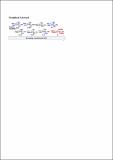| dc.contributor.author | Farrell, Mark P. | |
| dc.contributor.author | Doyle, Lisa M. | |
| dc.contributor.author | Murphy, Paul V. | |
| dc.date.accessioned | 2019-05-24T11:27:36Z | |
| dc.date.issued | 2018-05-26 | |
| dc.identifier.citation | Farrell, Mark P., Doyle, Lisa M., & Murphy, Paul V. (2018). Influence of acyl groups on glucopyranoside reactivity in Lewis acid promoted anomerisation. Tetrahedron Letters, 59(28), 2726-2731. doi: https://doi.org/10.1016/j.tetlet.2018.05.076 | en_IE |
| dc.identifier.issn | 0040-4039 | |
| dc.identifier.uri | http://hdl.handle.net/10379/15195 | |
| dc.description.abstract | Lewis acid promoted anomerisation has potential in O- or S-glycoside synthesis. Herein, the anomerisation kinetics of thirty-one β-d-glucopyranosides was determined to determine how particular acyl protecting groups and their location influence reactivity towards a Lewis acid promoted reaction. The replacement of acetyl groups with benzoyl groups led to reduced reactivity when located at O-3, O-4 and O-6. However a reactivity increase was observed when the acetyl group was replaced by a benzoyl group at O-2. The 2,3,4,6-tetra-O-(4-methoxy)benzoate had an⠯⠼2-fold increase in rate when compared to the tetrabenzoate. | en_IE |
| dc.description.sponsorship | This publication has partly emanated from research supported by Science Foundation Ireland (SFI, grant number 12/IA/1398) and is co-funded under the European Regional Development Fund under Grant Number 14/SP/2710. The authors thank the Irish Research Council and Roche Ireland Ltd for an Enterprise Partnership postgraduate scholarship to MPF. | en_IE |
| dc.format | application/pdf | en_IE |
| dc.language.iso | en | en_IE |
| dc.publisher | Elsevier | en_IE |
| dc.relation.ispartof | Tetrahedron Letters | en |
| dc.rights | Attribution-NonCommercial-NoDerivs 3.0 Ireland | |
| dc.rights.uri | https://creativecommons.org/licenses/by-nc-nd/3.0/ie/ | |
| dc.subject | Carbohydrates | en_IE |
| dc.subject | Anomerisation | en_IE |
| dc.subject | Glycoside | en_IE |
| dc.subject | Lewis acid | en_IE |
| dc.subject | Protecting groups | en_IE |
| dc.subject | Reactivity | en_IE |
| dc.title | Influence of acyl groups on glucopyranoside reactivity in Lewis acid promoted anomerisation | en_IE |
| dc.type | Article | en_IE |
| dc.date.updated | 2019-05-23T14:16:45Z | |
| dc.identifier.doi | 10.1016/j.tetlet.2018.05.076 | |
| dc.local.publishedsource | https://doi.org/10.1016/j.tetlet.2018.05.076 | en_IE |
| dc.description.peer-reviewed | peer-reviewed | |
| dc.contributor.funder | Science Foundation Ireland | en_IE |
| dc.contributor.funder | European Regional Development Fund | en_IE |
| dc.contributor.funder | Irish Research Council | en_IE |
| dc.contributor.funder | Roche Ireland Ltd | en_IE |
| dc.description.embargo | 2020-05-26 | |
| dc.internal.rssid | 16255768 | |
| dc.local.contact | Paul Murphy, School Of Chemistry, Room 108, Arts/Science Building, Nui Galway. 2465 Email: paul.v.murphy@nuigalway.ie | |
| dc.local.copyrightchecked | Yes | |
| dc.local.version | ACCEPTED | |
| dcterms.project | info:eu-repo/grantAgreement/SFI/SFI Investigator Programme/12/IA/1398/IE/Glycoside & glycoconjugate synthesis through development and application of chelation induced anomerization/ | en_IE |
| dcterms.project | info:eu-repo/grantAgreement/SFI/SFI Spokes Programme/14/SP/2710/IE/Gut Inflammation _ Discovery and Therapeutic Targeting of the Secretome-Receptome Inflammatory Network in Inflammatory Bowel Disease/ | en_IE |
| nui.item.downloads | 116 | |


